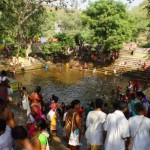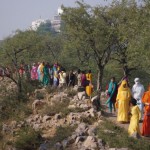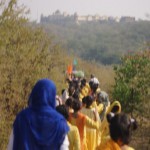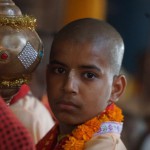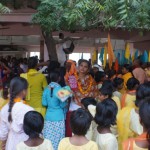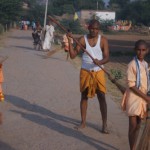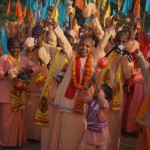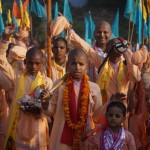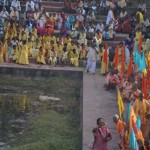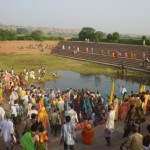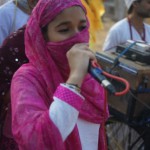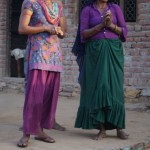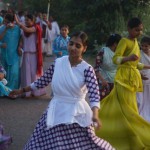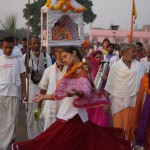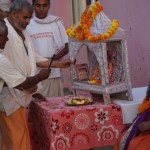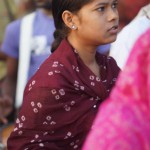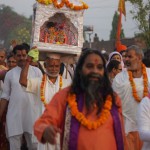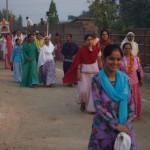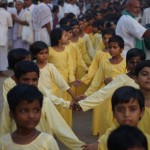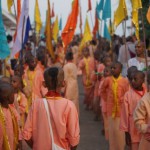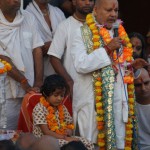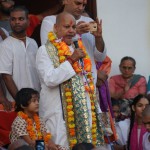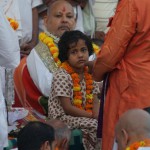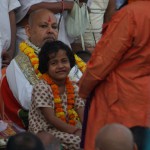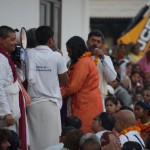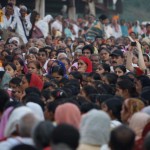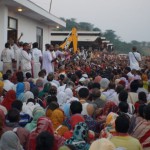Dabhala Village, Ratna Kuṇḍa, Naubāri Chaubari Palace, Rangadevi Sakhī’s Village, Mān Mandir, Jaipur Mandir, Dān Garh, Mor Kuti, Sankari Khor, Chiksoli Gram(Village), Bihara-Kuṇḍa
Today was the beginning to our 40-day yatra. After the ‘Yatra Shubharambh Puja’ (beginning puja) at Maan Mandir, Śrī Ramesh Bābāji Mahārāj, with great emotion placed the Lordships on his head. The saṅkalpa and worship of little Rādhārāṇī, was performed at the Mataji Gośala amidst a packed crowd of 10,000 pilgrims.
Then we walked through Rangasakhī’s (The 8th astha sakhī, intimate associate of Śrī Rādhā and Śrī Kṛṣṇa) village, enroute to Ratna-Kuṇḍa.
Because Vṛṣabhānuji was in great anxiety seeing the beautiful jewels, diamonds sent by Nanda Bābā in dowry before the marriage; Śrī Rādhā planted jewels in the ground that grew into small bushes with even larger more beautiful jewels, diamonds and pearls, to present to Vṛṣabhānuji in order to supersede the elaborate jewels sent by Nanda Bābā.
Naubāri Chaubari Palace was on the way, here is where little Rādhā would play with dolls in Her childhood.
Then we came to Maan Mandir, where the famous Maan Līlā pastimes took place, due to Kṛṣṇa’s antics, Rādhārani becomes angered and very difficult to appease. Of course this is Her way of enhancing the sweetness of their relation. The gopīs were exasperated in running up and down this hill to appease both parties, with Kṛṣṇa beckoning at the bottom, waiting for Śrīji to lose Her anger…which in time would always happen.
The next famous place is Dān Garh, where Thakurji would cruelly tax the gopīs for their milk products and feast on large amounts of makhan (butter) especially in the passage that is known as Sankari khor, the ravine like path the gopīs would use to bring their wares from Ciksoli to Barṣāṇā township. Many pranks, like breaking butter pots were performed by the gopas to unfarely steal from the gopīs. However, the tables turned when in time the gopīs themselves, with superior power in the Choti līlā, were able to arrest and tie the chotis(rear hairs) of the gopas and bring them into submission.
Then we went and paid respects to Mor Kuti.
Obeisance Mantra of Mor Kuti
kiritine namastubhym mor priybllbh! \
surmyayei mahakutyei shikhndipdveshmne \\
Dear Vallabha of Mor or obeisance to Mayur Ramnik Mukuti Kṛṣṇa and obeisance to Mor kuti. Mor kuti is above Dan Garh. Here many līlās have been performed. One is where Rādhā and Kṛṣṇa both danced there in form of peacocks.
Here Kṛṣṇa became a peacock for attracting Rādhā. When Śrīji was observing this peacock, She then said, “O my dear peacock also dance like this.” Kṛṣṇa had to leave this peacock form, revealing that, “I am your dear One.” She laughed and thus they met, and then both of Them performed a peacock dance together.
Another līlā is that the peacocks of Gahvarvan always come there. Then Śrīji told someone that, “He is My peacock,” and Thakurji picks another peacock and says that, “He is My peacock.” They both make wagers whose peacock will dance better than the other. Śrīji inspires Her peacock to dance, and Thakhurji causes His peacock to dance. Thus many līlās were performed in this way.
tato mayurkuti sthale ram mandal prarthnamantra
(aadirvarahe):-
namha sakhī smetay Rādhākrisnayte namah \
sakhī varg such praptay krida vimal darsane \\
We pay our obeisances to the sakhīs with Rādhā and Kṛṣṇa and to the Rāsa Maṇḍala; the pure festival ground and fortune of Braja. Here līlās related to the mor have been performed, like dances in imitation, and varieties of peacock dancing.
At Bihara Kuṇḍa Lord Śiva had a desire to become a gopī, for nomale can enter Lord Kṛṣṇa maha rāsa pastimes; here Pārvatī performed a Śrīngara seva of Śiva, dressing him up as a gopī.


